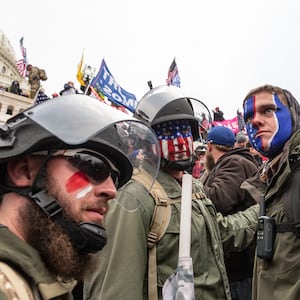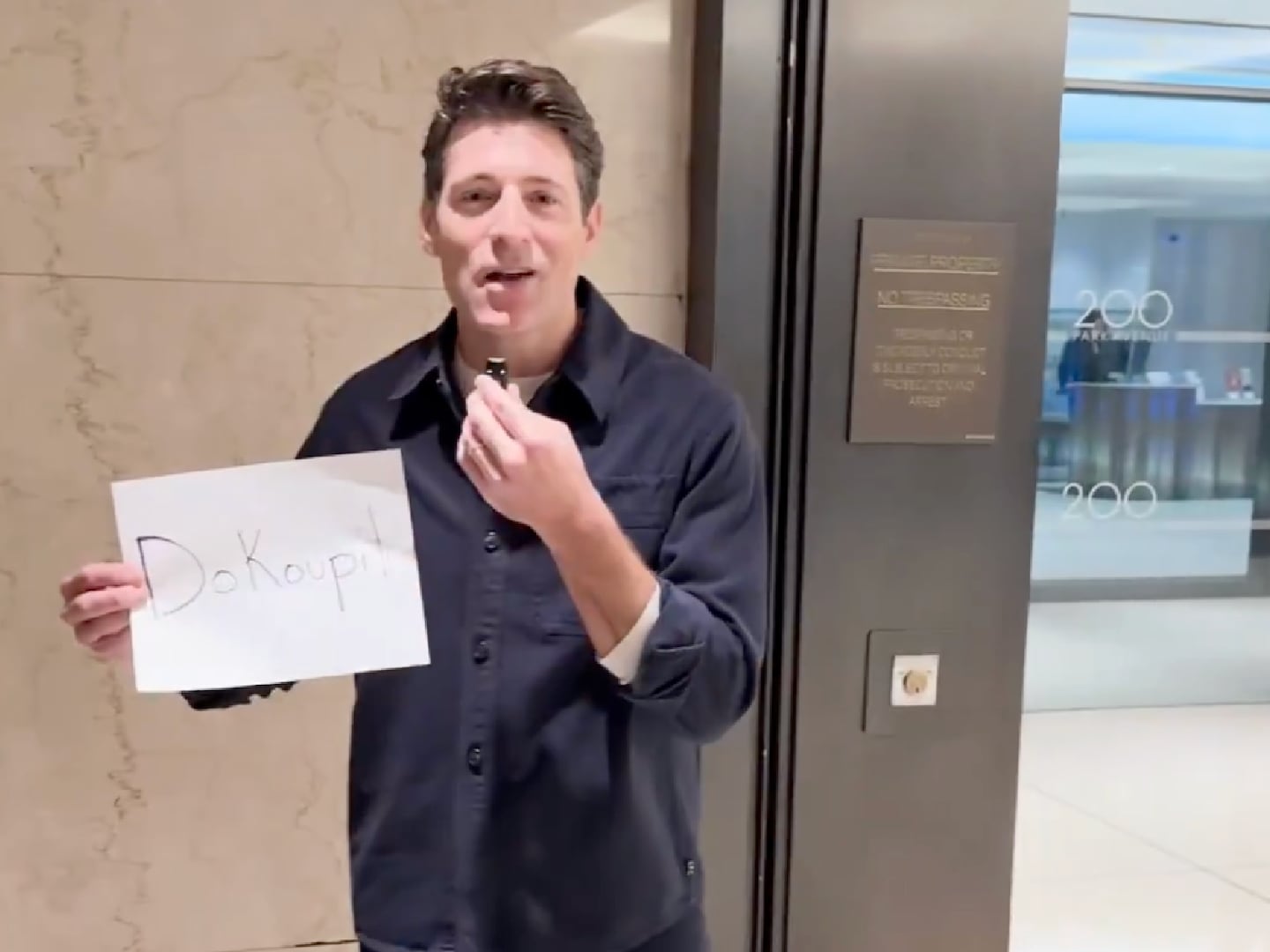A year later, the U.S. withdrawal from Afghanistan is still a blur.
For those of us watching from afar, the hasty airlifts looked more like the climax of a war movie than a coordinated military operation by the world’s only superpower. The month of August 2021 was filled with minute-to-minute updates on the chaos: the desperate masses trying to escape, the rapid advance of the Taliban, the terrorist attack at the Kabul airport, and the thousands of migrants filing into planes and arriving at makeshift resettlement centers across the world.
Now, director Jamie Roberts and the team at Amos Pictures have turned those events into a documentary, Escape From Kabul, premiering Wednesday on HBO Max. In a tight 77 minutes, Roberts merges hours of on-the-ground footage with stirring interviews from Afghan evacuees, American troops, and the Taliban for a compelling look into the human instinct to survive. We watch, for instance, as people stand in a flooded sewage canal in unbearable heat, hoping that a U.S. Marine will take pity on them and pick them out for resettlement. In another disturbing scene, a group of Afghan citizens, feeling like they have nothing to lose, hop on the wing of a massive C-17 military plane. The crowds rush toward the aircraft, but the American troops overseeing the evacuation still don’t know who’s who in the melee. The plane is ordered to take off, and a single body falls and splatters on the runway.
Roberts and his team started plotting the film within days of the U.S.’s withdrawal on Aug. 31, reaching out to the British and American military and figuring out how to make it over to Afghanistan. From January to March, they treaded carefully in Kabul, cautious not to provoke the Taliban’s ire.
The Daily Beast spoke with Roberts over Zoom about the making of the documentary, the Biden administration’s initial pushback, and the ripple effect of the disastrous evacuation for thousands of Afghans and their families.
It seems like with your past couple of documentaries [Escape from Kabul, Four Hours at the Capitol], you’ve worked pretty quickly. Is that new for you? Do you prefer it?
I’ve spent good amounts of time on films in the past where I’ve embedded for like a year with a group—a jihadi group, a far-right group—but I guess I like working at pace. Obviously if you’ve got longer, that’s great, but there’s some stories that feel like they are quite urgent. With this, HBO wanted something within the year. A deadline focuses the mind sometimes.
It was fascinating hearing from some of the evacuees who actually went through that nightmare, and seeing them side by side with uninterrupted footage of that horrible waiting period for weeks at the airport. How’d you get in touch with them?
Speaking to charities, speaking to people involved in the evacuation, and going through networks. We have Afghans working on the film, people I’d met and filmed with—they’re all on social networks. Everyone is messaging, especially because they’re spread all over the world, on WhatsApp, on Facebook. We really wanted people who had been down in the gates where the Marines were and the Talibs were, people who were in the frontlines in the canal where the bomb went off, to be able to keep the story very focused.

To me, the most surprising “get” was the U.S. servicemen and servicewomen—I guess because I thought the U.S. would want to keep that closer to the vest, since it was, in so many peoples’ opinions, a bungled evacuation. Did you go through official channels to get them?
With the Marines, on our first approach, we were rebuffed. We tried different ways and we spoke to Marines who have since left, and then we started rounds of talks with an intermediary that we met. And I think there was a groundswell within the Marines. They were frustrated that they hadn’t seen their story represented, that they hadn’t been heard. So I think the Marines as an organization decided maybe they would let their people speak on this. Over time, we managed to open that up, and when we turned up on the base, we were kind of amazed. Here they were. And the first guy who came in is [Lt. Col.] Chris Richardella, who is in the film and basically sits down and gives you a start-to-finish of when they deployed two days before the Taliban arrived, and then what happened when the Taliban got there, and what happened afterwards. And it felt like, OK, all of a sudden we’re right in the inside of the story.
Some of their stories seem like an indictment on the Biden administration’s handling of the evacuation. [The Marines] talked about the lack of focus or clear directions and everything they had to witness because of it, but of course, the administration has control over the Department of Defense and the military. Did that ever come up?
It came up. That’s why we didn’t get access to start with. We kept trying to knock on doors and explore why this was happening, and we were told it was coming from the administration. None of [the Marines] really sat there and gave it to Biden, but you’re right, there were frustrations about the situation they were put in. I think some people did link that back to Trump. Especially Afghans who were saying, “This is the deal Trump signed with the Taliban and didn’t have the Afghan government at the table,” and obviously Biden took the bat and continued that. He repealed almost everything else Trump did, but he continued this policy.
Was there anything you were surprised to uncover over the course of your reporting?
One of the things I hadn’t heard before—it’s alluded to in the DOD report, but it isn’t made explicit—is how the Marines actually got control of the airfield. They said, “Well, this Afghan special forces unit turned up and said, ‘OK, we’re gonna partner with you.’” They had different rules of engagement, so they started running people over and shooting them, and it was only then they got control of the actual airport and could start the evacuation. The first person that told me that, I didn’t actually believe them. Then another person says it, and another person says it. Then you start to triangulate it, and you look back at the paperwork. That was shocking.

You also see there’s several really strong, brilliant characters. There’s Hasina Safi, who was a member of the Afghan government. She’d been told several times before that the Taliban were going to kill her, that she was gonna be assassinated. It’s shocking to see a woman like that who’s so gentle, who doesn’t pose a threat to anybody, who’s intelligent, to then have to try to round up her family, wade through a canal, [and] go through this deadly assault course to get out in the way that she did.
I helped report on the evacuation myself. I was glued to the updates in the form of videos and photos, but it wasn’t until your film that I saw it all so clearly and uninterrupted. How did you get so much raw footage?
I got some from the Taliban. One guy I met, we got talking and it turns out he was actually part of the special forces unit who went into the airport directly after the Americans left and he filmed his buddies going in. He was like, “This is our moment.” After a few meetings over coffee—green tea—he ended up giving it to me. I was quite amazed because it’s a scene. You get taken through their experience. You can see they’re happy but quite terrified because they think the whole place is rigged with bombs and they’re gonna go off.
There’s one guy, I feel like he was a citizen journalist, but he filmed the Taliban coming in. I think he just realized it was such a historic moment. And it was something they hadn’t seen in Kabul before. There’s the footage there with people who were filming right in the drainage canal where the suicide bomb went off. So it’s not just pulled from archives from all the normal broadcasters and from a remove. You’re seeing it from the experience of the people right at the center of it.

And after all that, Biden called it an “extraordinary success.”
The acting ambassador himself says it wasn’t a success. I was surprised he even said that, because he was very diplomatic in his interview. You could see that none of these people thought that. The servicemen were very respectful of the president and the government. I’m sure when they went out of the room, they were angry, but they were quite professional. They all thought it was a complete shitshow. They were lucky to get out alive, and they saw 13 of their colleagues and hundreds of Afghans die. A lot of them thought they were gonna go in and fight the Taliban. They got there and they figured out it was a completely different thing.
Speaking of the Taliban, I think we’ve seen from news clips and other documentaries that the Taliban are not press-shy, especially not after they’ve taken control. But how was it for you to sit in front of them? Were you scared?
When we got to the point where we sat down, we’d kind of gone past the point of threat. I mean, they’re there with all their machine guns. They’ve turned up with RPGs, but it becomes quite normal, I suppose. The main feeling of threat was when we were filming around Kabul at night or going through checkpoints. There were journalists getting arrested. You go through a checkpoint and they’d stop your car and they had booze all over the road because they’d been stopping people looking for alcohol. They were going house to house, kicking in doors, breaking people’s equipment, looking for spies. It all seemed very reactionary, and you didn’t really know what, day to day, might happen. Almost every other week there would be a Western journalist or contractor getting picked up and arrested. There’s no U.S. or British embassy there, so you’re there kind of on your own. The times I saw people get in trouble was when they did things that basically pissed off the Taliban immediately and stepped outside the rules. Like taking a picture of someone’s face for no real reason, and then you end up in jail and you’re not gonna get out for God knows how long, because you’ve now become a political asset.
This interview has been edited and condensed for clarity.







